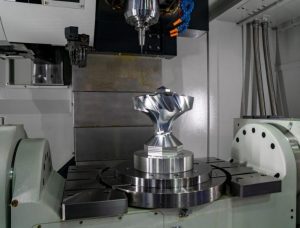How Does 5 Axis CNC Machining Work?
5 axis CNC machining represents the pinnacle of precision engineering, offering unparalleled versatility and accuracy in manufacturing processes. Understanding how this advanced technology operates is crucial for appreciating its myriad applications and advantages.

Operation Principles
At its core, 5 axis CNC machining relies on sophisticated computer numerical control (CNC) systems to precisely control the movement of cutting tools along multiple axes. Unlike traditional machining techniques limited to three axes (X, Y, and Z), 5 axis CNC machining adds rotational axes, enabling cutting tools to approach the workpiece from multiple angles. This capability allows for the fabrication of intricate geometries and complex surfaces with unprecedented precision.
Versatility and Flexibility
One of the primary advantages of 5 axis CNC machining is its unmatched versatility. By enabling simultaneous movement along multiple axes, this technology can fabricate intricate components in a single setup, reducing production time and eliminating the need for manual repositioning. Moreover, 5 axis CNC machines can accommodate a wide range of materials, including metals, plastics, composites, and more, making them indispensable tools across various industries.
Precision and Accuracy
5 axis CNC machining excels in delivering precise and accurate results, even for the most complex geometries. The ability to approach the workpiece from multiple angles ensures uniform material removal and consistent surface finish, minimizing the need for secondary operations. Additionally, advanced CNC control systems incorporate real-time feedback mechanisms to adjust tool paths dynamically, further enhancing precision and ensuring dimensional accuracy within tight tolerances.
Efficiency and Productivity
Despite its advanced capabilities, 5 axis CNC machining offers remarkable efficiency and productivity. By reducing setup times and streamlining production workflows, manufacturers can optimize throughput and minimize idle time, maximizing the utilization of machining resources. Furthermore, the ability to produce complex components in a single operation reduces lead times and accelerates time-to-market, giving businesses a competitive edge in today's fast-paced market.
Cost Considerations
While 5 axis CNC machining represents a significant investment, its long-term benefits often justify the initial cost outlay. By eliminating the need for multiple setups and reducing scrap rates through precise machining, 5 axis CNC technology can yield substantial cost savings over time. Additionally, the versatility of these machines allows manufacturers to undertake a wide range of projects, expanding their capabilities and revenue streams.
Conclusion
In conclusion, 5 axis CNC machining stands as a testament to the relentless pursuit of precision, efficiency, and innovation in manufacturing. By leveraging advanced technology to manipulate cutting tools along multiple axes, this technology unlocks new possibilities in design complexity and manufacturing capability. From aerospace components to medical implants and beyond, 5 axis CNC machining continues to redefine the boundaries of what's possible in modern manufacturing.
For more information, visit 5 axis CNC machining.